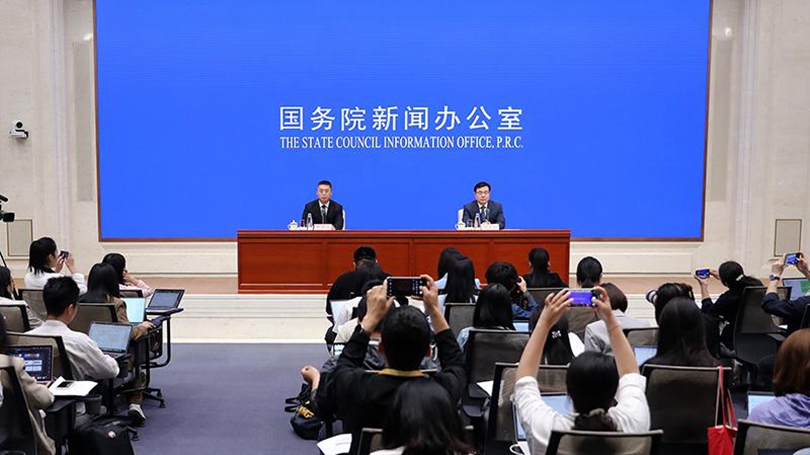Bloomberg:
We're wondering, what is the expected impact of the China-U.S. agreement reached in Geneva on China's economic performance? And if tariffs remain at the current levels, what are your expectations for export growth, employment and domestic prices this year? Thank you.
Fu Linghui:
Thank you for your questions. Since the beginning of this year, the international environment has undergone complex changes. The United States has taken a series of unilateral measures to impose high tariffs on China, severely impacting China-U.S. economic and trade relations. In response, China has taken resolute and strong countermeasures. From May 10-11, China and the United States held a high-level meeting on economic and trade affairs in Geneva, Switzerland, where both sides agreed to significantly reduce tariffs. In this context, there is considerable public interest in the trend and prospects of the Chinese economy.
Looking forward to the next stage, the international environment remains complex and challenging, with many unstable, uncertain and unpredictable factors. Domestic cyclical and structural contradictions are intertwined. However, the fundamentals sustaining China's sound economic growth have not changed. Various macro policies are making concerted efforts. All parties are focused on tackling challenges and actively responding to changes, and the driving force for innovation continues to grow. There are many favorable conditions for the continued recovery of the economy.
First, there is a foundation for recovery. Although the impact of external shocks increased in April, the trend of economic recovery has not changed. According to the major indicators, market sales and the service industry, which are closely linked to the domestic market, continued to rise steadily. From January to April, the total retail sales of consumer goods and the index of services production increased by 4.7% and 5.9%, respectively, both 0.1 percentage point higher than in the first quarter. The exports of goods and industrial production, which are more affected by the international market, remained generally stable. From January to April, exports increased by 7.5%, 0.6 percentage point higher than that in the first quarter; and the added value of industrial enterprises above designated size increased by 6.4%, maintaining overall stability.
Second, there is policy support. Since the beginning of this year, we have implemented more proactive and effective macro policies and increased policy support for the implementation of major national strategies and the building up of security capacity in key areas as well as the promotion of large-scale equipment upgrades and trade-in programs for consumer goods, expanding market demand, driving enterprise production, supporting innovative development and boosting market confidence, with the effects continuing to show. From January to April, the growth rates of major production and demand indicators were significantly faster than the whole of last year. Driven by large-scale equipment renewals, investment in the purchase of equipment increased by 18.2% year on year from January to April, contributing 64.5% to the total investment growth. Recently, relevant departments further cut the reserve requirement ratio (RRR) and interest rates, and established new policy-based financial instruments to support technological innovation and expand consumption. As various policies of the Party Central Committee and the State Council are gradually implemented, it will be conducive to the sustained recovery and improvement of the economy.
Third, there is consumption potential. All regions and departments have conscientiously implemented the decisions and plans of the Party Central Committee, vigorously carried out special actions to boost consumption, intensified and expanded the implementation of the policies of large-scale equipment renewal and consumer goods trade-ins, created diversified consumption scenarios, and actively expanded service consumption, with the effects continuing to emerge. In April, the retail sales of household appliances and audio-visual equipment, cultural and office supplies, furniture, communication equipment, and building and decoration materials related to the trade-in of consumer goods contributed 1.4 percentage points to the growth of total retail sales of consumer goods. From January to April, the retail sales of services increased by 5.1%, rising for two consecutive months. During the May Day holiday, the number of domestic tourists increased by 6.4% year on year. As the policies continue to take effect and consumption momentum continues to grow, the role of consumption in stimulating economic growth is expected to continue to strengthen.
Fourth, there is innovation momentum. All parties have actively promoted the in-depth integration of technological innovation and industrial innovation, promoted the transformation of technological creativity into social productive forces, and continued to reinforce the leading role of innovation, continuously injecting new momentum into economic development. The high-tech industries and emerging service industries have shown sound growth momentum. In April, the value added of high-tech manufacturing enterprises above designated size rose 10% year on year, 3.9 percentage points higher than that of all industrial enterprises above designated size. From January to March, the operating revenue of strategic emerging service enterprises above designated size increased by 8.3% year on year, maintaining rapid growth. The intelligent and green transformations of industries are accelerating, with the added value of the intelligent unmanned aerial vehicle manufacturing industry increasing by 74.2% in April, and the production of new energy vehicles (NEVs) increasing by 38.9%. Breakthroughs have been made in cutting-edge technology fields such as large AI models and humanoid robots, which will further promote industrial upgrading and development.
Overall, supported by multiple favorable factors, China's economy is expected to maintain overall stable performance and steady growth. Thank you.


 Share:
Share: 




 京公网安备 11010802027341号
京公网安备 11010802027341号